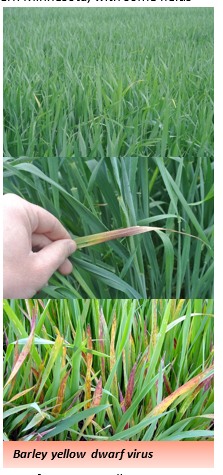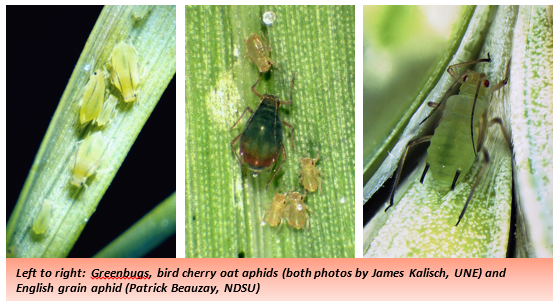Scouting for Cereal Aphids in Wheat and Barley
This page was adapted from the article, "Cereal Aphids in Wheat and Barley," which appeared in Crop & Pest Report on June 10, 2021.
Scouting for cereal aphids is easy and should begin at stem elongation. Look on the undersides of leaves and near the base of the plant for the tiny ⅛-inch long, greenish and pear-shaped aphids. IPM scouts observed both winged and wingless aphids as well as a mother aphid with young. The most common species observed last week was the English grain aphids in ND wheat fields, but an IPM scout found bird cherry oat aphids in one wheat field of Minnesota (Source: Dr. Jochum Wiersma, UMN Extension). Bird cherry oat aphid is known for being the most effective vector of BYDV. Barley yellow dwarf can stunt plants and reduce yield. Symptoms of BYDV is a yellowing to reddish color near tips of leaves, often the flag leaf.
When temperatures are in the low to mid-80s F, conditions are favorable for fast aphid reproduction in <7 days. Drought stress also can increase the susceptibility of wheat or barley crop to feeding injury by cereal aphids.
Continue scouting for cereal aphids for the next month in wheat (spring, durum and winter), oat and barley, or until the crop gets past the end of heading stage.
For a scouting protocol, walk a Z or W pattern across the field and inspect 10 randomly selected stems at 5 sites for cereal aphids. Calculate the percent of infested plants (incidence) with one or more aphids. The economic threshold is 85% of the plants infested and prior to the completion of heading. Heavy infestations of cereal aphids can reduce grain quality (protein and test weight). No insecticides are necessary after the onset of flowering, since the negative impacts of cereal aphid feeding are reduced (no yield loss).


For more information, see the North Dakota Field Crop Insect Management Guide.
Janet J. Knodel
NDSU Extension Entomologist
